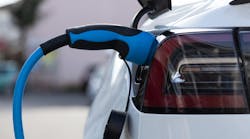Demand for EVs Puts New Pressures on Auto Supply Chains
Download this article in PDF format.
About 10 million electric vehicles (EVs) were sold to customers around the world last year, with EV sales are expected to continue their strong, upward trajectory in 2023 and beyond. By the International Energy Agency’s (IEA) estimates, dealers will sell 14 million EVs this year, representing a 35% year-over-year increase compared to 2022. At that point, EVs will account for 18% of total car sales in 2023, up from around 4% in 2020.
As the number of EVs on the world’s roads continues to increase, the automotive supply chain is having to play a bit of catchup to get out in front of the demand and meet its customers’ growing appetite for electric vehicles. In “How EVs are upending the 100-year-old auto supply chain,” CNBC’s Robert Ferris paints a picture of an antiquated network that may not have been prepared for the quick shift away from internal combustion engines.
Shifting Circumstances
Citing a recent Deloitte Automotive Supplier Study, Ferris says revenues for internal combustion engines, as well as fuel and exhaust systems, are expected to decline 44% through 2027. Meanwhile, revenues for electric drivetrains and batteries or fuel cells are expected to rise 245%.
“While the supply chain is shifting away from parts, the total powertrain part supply pie is also shrinking,” Ferris writes. “An internal combustion powertrain has about 2,000 parts. Battery electric vehicle powertrains have about 20, sometimes less.”
Tesla’s EV-first approach is serving as a guide for some manufacturers. “With electric car battery costs on the rise, auto companies are doing everything they can to make their EV offerings more affordable for the masses in the coming years,” Alexa St. John writes in Business Insider. “Making that happen may require forgetting much of what they’ve learned about supply chains over a century, and replacing it with a few pages from Tesla's playbook.”
Automakers have also been exploring different kinds of batteries to slash their dependence on the in-demand materials found in traditional lithium-ion setups, the publication reports. Others are ramping up battery recycling efforts and working to return lithium, nickel, cobalt and more into the supply chain.
“These solutions come with challenges in terms of timing and expense, at least in the near term,” St. John points out. “That means car companies are seeking an alternative and racing to secure their battery supply in the US.”
Building Momentum
In “America’s EV transition needs to tackle supply chain issues,” Walid Al-Hajj says that as America steadily builds momentum to become an EV powerhouse in the next decade, outdated and rigorous supply chain constraints will see the country falling further behind other countries in this quest.
“Countless supply chain issues are further dampening legacy car makers and the Biden Administration’s efforts to make 50% of all cars on American roads fully electric by 2030,” Al-Hajj writes. Also in the article, Axlewise’s Matthew Hart discusses how America’s “newfound love and interest for EVs” has further highlighted how far behind the U.S. has fallen in the EV race.
“However, as electric cars continue to become more affordable and accessible, new players are entering the market daily,” Hart told Business Insider. “This is creating both challenges and opportunities for existing manufacturers and consumers alike. Overall, it is clear that electric car prices will continue to rise over the next decade as demand continues to increase.”
4 Tips for Auto Manufacturers
Looking ahead, Plante Moran’s Daron Gifford expects EVs to bring about “dramatic transformation” within the automotive supply chain. Knowing this, he says suppliers should be taking action to transform their operations to be more competitive on the EV front, with the key steps being:
- Evaluate and restructure your product portfolio. “Understanding how EV technologies could replace your current products will be critical to meeting your customers’ future requirements,” Gifford writes in Area Development.
- Take more risk with your capital investment decisions. “Unless your products and manufacturing capabilities can be easily transitioned to electric products, longer term approaches to analyzing investment returns, while not popular, will be needed to make such a significant transformation,” he advises.
- Invest more in your people and technology. Gifford says offshoring engineering and manufacturing to low-cost countries has contributed to the current supply crisis. “Even in the midst of the current labor shortage,” he adds, “developing the strategy for upskilling the workforce through more education and training will be crucial.
- Build stronger relationships. “OEMs and tier suppliers will need lots of help beyond their existing pools of expertise,” Gifford points out, “whether for new product development, engineering or production.”








